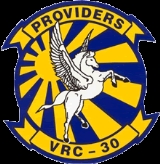
VRC-30
Encyclopedia
Fleet Logistics Support Squadron 30 (VRC-30), also known as the "Providers", is a United States Navy
Fleet Logistics Support squadron based at Naval Air Station North Island
consisting of 5 detachments.
"Norseman" aircraft in regular air service to Seattle, Oakland, San Francisco, the Aleutian Islands, Fairbanks and Point Barrow on the Alaskan Mainland.
aircraft, the TBM-3Rs, transport version of the TBM-3E the General Motors version of the World War II Grumman Avenger torpedo bomber.
On June 26, 1958, VR-21 NAS North Island Detachment made the first COD with the Grumman C-1A Trader aircraft to the . The Detachment relocated to NAS Alameda in 1960.
In 1969, squadron C-1A's and crews operated from Danang, Republic of Vietnam in support of CTF-77. In 1971 VR-30 joined the Jet Age with two North American CT-39 Saberliners for high-speed executive airlift. In May 1973 the squadron received the first of four C-9B Skytrain II's to further improve its logistics support capability.
and the Forward Deployed Naval Forces. Four deployable sea going detachments were formed at North Island, supported by a "homeguard" shore component. In 1997 VRC-30's detachment Three became the first fully integrated, night capable C-2 detachment when it deployed with CVW-2 aboard .
1998 proved to be another banner year for the Providers at VRC-30. Provider detachments continued to set the standard for day/night logistics support with two highly successful deployments. Detachment One posted an impressive total of over 290,000 lbs. of cargo, 175,000 lbs. of mail, and over 2300 passengers carried in support of the Battlegroup. While on WESTPAC Detachment One earned the Golden Hook Award for the best landing grades in the Airwing, a squadron first. Detachment Two aboard followed suit, operating daily in support of Operation Desert Fox
and Operation Southern Watch
. In calendar year 1998, VRC-30 was able to accomplish astounding results including: 1356 carrier landings, 14,360 passengers, 1,877,973 lbs of cargo, and a sortie completion rate of 99.9%.
As of December 1999, the squadron has achieved 24 years and over 149,600 hours of accident-free flight. VRC30 was awarded the Chief of Naval Operations Safety Award six times between 1979 and 1992 and the Meritorious Unit Commendation
for exemplary service from October 1993 to September 1994. In 1996 the Providers were awarded their first ever Commander, Naval Air Forces Pacific Battle Efficiency Award and again received the honor in 1998. VRC-30 again garnered the CNO Aviation Safety Award in 1998. In March 1998 the command adopted a full detachment concept, as a result of a 140 person reduction in manning. As a result; all five detachments have remained active throughout the turn around cycle.
United States Navy
The United States Navy is the naval warfare service branch of the United States Armed Forces and one of the seven uniformed services of the United States. The U.S. Navy is the largest in the world; its battle fleet tonnage is greater than that of the next 13 largest navies combined. The U.S...
Fleet Logistics Support squadron based at Naval Air Station North Island
Naval Air Station North Island
Naval Air Station North Island or NAS North Island is located at the north end of the Coronado peninsula on San Diego Bay and is the home port of several aircraft carriers of the United States Navy...
consisting of 5 detachments.
History
Fleet Logistics Support Squadron Three Zero (VRC-30), traces its ancestry to Air Transport Squadron Five (VR-5) which was commissioned on June 24, 1943 at Naval Air Station Seattle. The Squadron was tasked with flying the Douglas R4D "Skytrain", R5D "Skymaster", Beechcraft SNB "Expeditor" and the Noorduyn JA-1Noorduyn Norseman
The Noorduyn Norseman is a Canadian single-engine bush plane designed to operate from unimproved surfaces. Norseman aircraft are known to have been registered and/or operated in 68 countries throughout the world and also have been based and flown in the Arctic and Antarctic regions.-Design and...
"Norseman" aircraft in regular air service to Seattle, Oakland, San Francisco, the Aleutian Islands, Fairbanks and Point Barrow on the Alaskan Mainland.
1940s
In 1948, the Naval Air Transportation Service and Air Transport Command merged and became the Military Air Transport Service. VR-5 was placed under the command of Fleet Logistics Support Wing, U.S. Pacific Fleet.1950s
In 1950, VR-5 moved its base of operations from NAS Seattle to NAS Moffett Field, CA. Detachments were established in Seattle and at NAS North Island, CA. VR-5 was decommissioned July 15, 1957 and became VR-21, with detachments at NAF Atsugi, Japan and NAS North Island. VR-21 was the first squadron to fly dedicated Carrier Onboard Delivery (COD)Carrier onboard delivery
Carrier Onboard Delivery is a military term used to describe type of aircraft which are able to ferry personnel, mail, and high-priority cargo on and off a naval ship .-History:...
aircraft, the TBM-3Rs, transport version of the TBM-3E the General Motors version of the World War II Grumman Avenger torpedo bomber.
On June 26, 1958, VR-21 NAS North Island Detachment made the first COD with the Grumman C-1A Trader aircraft to the . The Detachment relocated to NAS Alameda in 1960.
1960s
On 1 October 1966 VR-21 was decommissioned. The Atsugi Detachment became VRC-50, and the Alameda Detachment was commissioned as Fleet Tactical Support Squadron Three Zero (VR-30) equipped with Convair C-131 Samaritans and C-1A Trader aircraft. VR-30's mission included logistics support for Commander in Chief U.S. Pacific Fleet units. On November 9, 1966, VR-30 made their first COD arrested landing in the C-1A on the . The squadron was awarded the Meritorious Unit Commendation for exemplary service from January 1 to November 30, 1967. From 1968 to 1973, VR-30 COD detachments operated aboard various carriers in support of recovery operations for Apollo X, XI, XII, and XVI.In 1969, squadron C-1A's and crews operated from Danang, Republic of Vietnam in support of CTF-77. In 1971 VR-30 joined the Jet Age with two North American CT-39 Saberliners for high-speed executive airlift. In May 1973 the squadron received the first of four C-9B Skytrain II's to further improve its logistics support capability.
1970s
On 12 March 1974 the Navy's first female Aviator, Lieutenant (Junior Grade) Barbara A. Allen reported for duty. After relocating to NAS North Island, VR-30 was decommissioned on 1 October 1978 and VRC-30 was concurrently commissioned. VRC-30 transitioned to the C-2A in late 1981 by accepting deliveries of the first "Greyhounds", the aircraft the squadron operates today.1980s
In February 1980, VRC-30 added the C-12 Fleet Replacement Squadron, providing ground and flight instruction for all Pacific Fleet Navy and Marine Corps Pilots and Aircrew in the UC-12B/F Beechcraft Super King Air. VRC-30's C-12 FRS acts as the Commander, Naval Air Force, U.S. Pacific Fleet NATOPS Model Manager and Unit Evaluator, in addition to their primary job of flight instruction.1990s
In 1994 VRC-30 took sole responsibility for Pacific Fleet C-2 operations by absorbing personnel and aircraft when VRC-50 was decommissioned. VRC-30 DET Five was established in August 1994 in Atsugi, Japan as part of Carrier Air Wing FiveCarrier Air Wing Five
Carrier Air Wing Five , is a United States Navy aircraft carrier air wing based at Naval Air Facility Atsugi, Japan. The air wing is attached to the aircraft carrier USS George Washington .-Mission:...
and the Forward Deployed Naval Forces. Four deployable sea going detachments were formed at North Island, supported by a "homeguard" shore component. In 1997 VRC-30's detachment Three became the first fully integrated, night capable C-2 detachment when it deployed with CVW-2 aboard .
1998 proved to be another banner year for the Providers at VRC-30. Provider detachments continued to set the standard for day/night logistics support with two highly successful deployments. Detachment One posted an impressive total of over 290,000 lbs. of cargo, 175,000 lbs. of mail, and over 2300 passengers carried in support of the Battlegroup. While on WESTPAC Detachment One earned the Golden Hook Award for the best landing grades in the Airwing, a squadron first. Detachment Two aboard followed suit, operating daily in support of Operation Desert Fox
Operation Desert Fox
The December 1998 bombing of Iraq was a major four-day bombing campaign on Iraqi targets from December 16–19, 1998 by the United States and United Kingdom...
and Operation Southern Watch
Operation Southern Watch
Operation Southern Watch was an operation conducted by Joint Task Force Southwest Asia with the mission of monitoring and controlling airspace south of the 32nd Parallel in Iraq, following the 1991 Gulf War until the 2003 invasion of Iraq.-Summary:Operation Southern Watch began on 27 August 1992...
. In calendar year 1998, VRC-30 was able to accomplish astounding results including: 1356 carrier landings, 14,360 passengers, 1,877,973 lbs of cargo, and a sortie completion rate of 99.9%.
As of December 1999, the squadron has achieved 24 years and over 149,600 hours of accident-free flight. VRC30 was awarded the Chief of Naval Operations Safety Award six times between 1979 and 1992 and the Meritorious Unit Commendation
Meritorious Unit Commendation
The Meritorious Unit Commendation is a mid-level unit award of the United States military which is awarded to any military command which displays exceptionally meritorious conduct in the performance of outstanding service, heroic deeds, or valorous actions....
for exemplary service from October 1993 to September 1994. In 1996 the Providers were awarded their first ever Commander, Naval Air Forces Pacific Battle Efficiency Award and again received the honor in 1998. VRC-30 again garnered the CNO Aviation Safety Award in 1998. In March 1998 the command adopted a full detachment concept, as a result of a 140 person reduction in manning. As a result; all five detachments have remained active throughout the turn around cycle.
2000s
The Providers delivered over 2.1 million pounds of cargo and mail to the fleet and more than 16,000 passengers and Distinguished Visitors were safely transported to and from carriers at sea. In addition, the FRS side of the house trained 82 new fleet ready C-12 pilots and instructor pilots and 47 newly qualified C-12/26 aircrew.Detachments
| Detachment 1 | Detachment 2 | Detachment 3 | |
|---|---|---|---|
 |
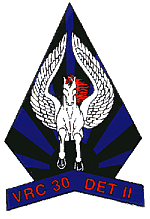 |
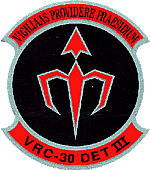 |
| Detachment 4 | Detachment 5 |
|---|---|
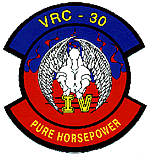 |
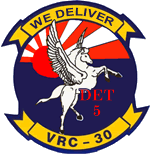 |
See also
- History of the United States NavyHistory of the United States NavyThe history of the United States Navy divides into two major periods: the "Old Navy", a small but respected force of sailing ships that was also notable for innovation in the use of ironclads during the American Civil War, and the "New Navy", the result of a modernization effort that began in the...
- List of United States Navy aircraft squadrons

